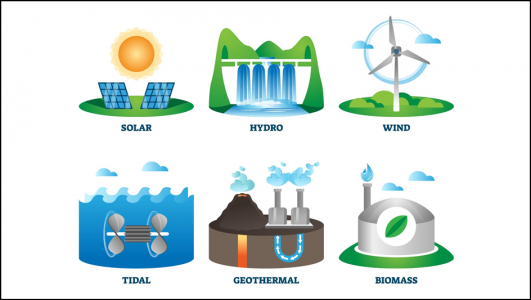With rising energy costs affecting bills, people are looking at various renewable energy sources. People from different places are exploring various alternative energy methods that will support the areas where they live and which types will be the most popular. Remember that no matter how popular a renewable energy source has gotten in an area, they all come with different challenges and advantages.

Renewable
Energy Sources
As the name suggests, renewable energy sources do not run out. These energy sources recharge themselves and are, therefore, sustainable. Renewable energy sources are alternatives to traditional sources like coal, oil, and gas. When you hear "Renewable Energy Source," your thoughts automatically go to green and clean energy.
This is a common misconception, as not all of the various types of renewable energy sources are good for the environment.
Types of Renewable Energy Sources
These types of energy come from the sun, wind, water, Earth, and biomass. This means that it is influenced mainly by weather conditions. There are six main types of renewable energy sources.
Solar Energy. This is energy harvested from the sun. Solar panels
transform sunlight into electricity. The amount of solar panels depends on the amount of energy that it needs to supply. It can vary from just four panels for a house to an entire farm dedicated to generating energy for buildings and neighbourhoods. This energy source does not produce any greenhouse gases or other pollutants. It is a renewable energy source that is both clean and green. There are different solar energy trends in the United Kingdom. New Zealand uses a lot of solar energy, along with China.
Wind Energy. The wind generates this energy. Wind turbines are
enormous structures with blades that are turned by the wind. When the blades turn, they power generators. These turbines are located in areas with high winds, like hills, fields, plains, and offshore regions. Nowadays, wind turbines come in miniature sizes that people can place in their gardens. Unfortunately, giant wind turbines are very noisy and considered an eyesore. Offshore turbines also get damaged a lot when the environment is too violent. Wind energy is clean and green but not necessarily environmentally sustainable. Just like solar energy,
New Zealand and China use a great amount of wind energy.
Hydroelectric Energy. This is energy created by the force of water. Blades of turbines are turned by water that moves rapidly, powering generators with energy. These water sources are usually rivers, dams,
and waterfalls. These sources are called "plants". They divert water
from its natural path, which can harm the area's plants, animals, and people. It also only generates power as long as there is water flowing. It can be an energy source that is not green or clean. This renewable energy source is mainly found in Norway and Switzerland.
Geothermal Energy. This energy comes from the Earth's core. Wells are drilled to bring extremely hot water up to the surface. This hydrothermal resource is used to turn turbines and generate energy. This type of energy can only be sourced in areas with geothermal resources. Since drilling is involved, the drill probably damages the environment with greenhouse gases. The surrounding area is also affected by what is essentially a mining process. Geothermal energy is not entirely clean or green. This energy source is used mostly in Iceland, El Salvador, and Kenya.
Biomass Energy. This energy is obtained by burning organic material from fauna and flora, like waste wood, trees, and crops. The heat produced by burning these materials powers a steam turbine, which
generates energy. The biomass that is burned can be sourced in a sustainable way or not. The burning process usually also produces greenhouse gases. This can be very bad for the environment. It is not really a clean or green renewable energy source. This source of energy is mainly found in Brazil and Finland.
Tidal or Wave Energy. This energy is generated by the wavelike movement of water. It is a newer source of energy. Waves are created by the pull of the moon's gravity on the ocean's water or the tides in a big freshwater source. Turbines are turned by the ebb and flow of waves and tides, storing energy in generators. Although, the structures that have to be built and put in place for this type of energy are not environmentally friendly. It can have a negative effect on wildlife, plants, and people in the affected areas, making it only relatively clean and green. South Korea is the foremost user of this type of energy.
Importance of Renewable Energy Sources
These energy sources are important for various reasons. You have free energy if you have your sources, like solar panels for your house or business. The energy source will never run out, so you will never be without electricity. If you have any excess energy you aren't using, you can sell it back to the National Grid and earn some extra money. It lowers the costs of your energy bills. You become more independent
from energy suppliers. Sites for renewable energy generation create many jobs that weren't previously available. By using renewable energy sources and becoming more environmentally sustainable, you are fighting against climate change and global warming.
Conclusion
This article explored the various types of renewable energy sources and where they are most popular. The subtle differences between Green, Clean, and Renewable Energy are mentioned. A description is given of what renewable energy sources are. The six different types of renewable energy sources that are given and explained are solar energy, wind energy, hydroelectric energy, geothermal energy, biomass energy, and tidal energy. The importance of renewable energy sources is also explained.